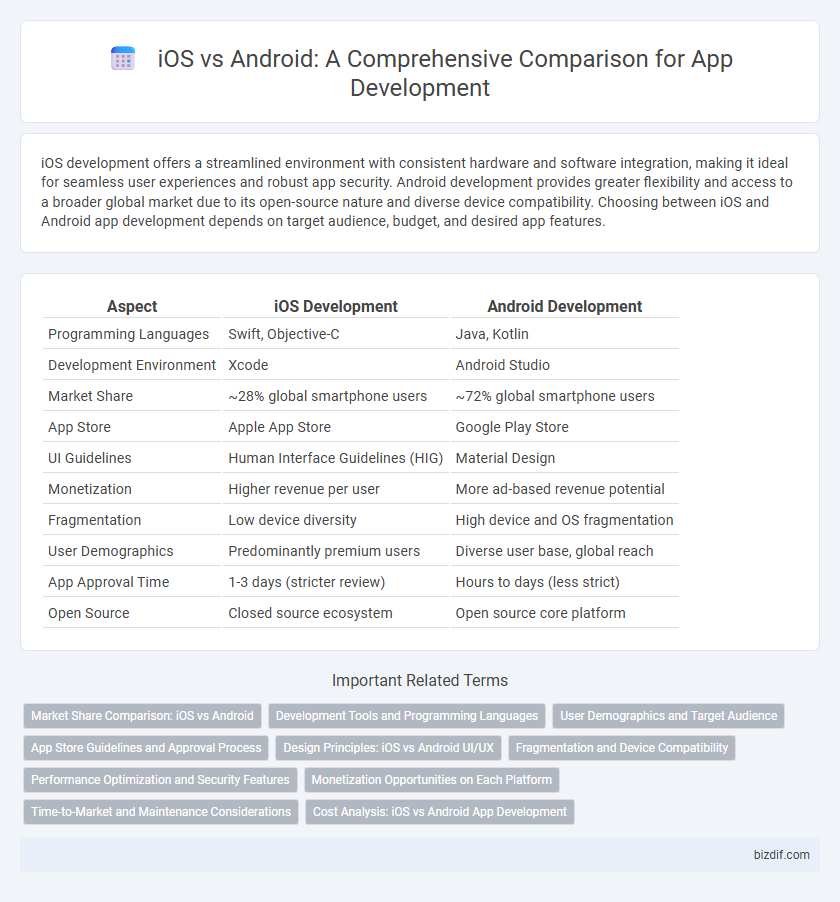iOS development offers a streamlined environment with consistent hardware and software integration, making it ideal for seamless user experiences and robust app security. Android development provides greater flexibility and access to a broader global market due to its open-source nature and diverse device compatibility. Choosing between iOS and Android app development depends on target audience, budget, and desired app features.
Table of Comparison
| Aspect | iOS Development | Android Development |
|---|---|---|
| Programming Languages | Swift, Objective-C | Java, Kotlin |
| Development Environment | Xcode | Android Studio |
| Market Share | ~28% global smartphone users | ~72% global smartphone users |
| App Store | Apple App Store | Google Play Store |
| UI Guidelines | Human Interface Guidelines (HIG) | Material Design |
| Monetization | Higher revenue per user | More ad-based revenue potential |
| Fragmentation | Low device diversity | High device and OS fragmentation |
| User Demographics | Predominantly premium users | Diverse user base, global reach |
| App Approval Time | 1-3 days (stricter review) | Hours to days (less strict) |
| Open Source | Closed source ecosystem | Open source core platform |
Market Share Comparison: iOS vs Android
Android dominates the global mobile market with over 70% market share, making it the preferred platform for app developers targeting diverse and high-volume audiences. iOS holds approximately 25-30% market share but captures a larger share of revenue, particularly in North America and Western Europe, attracting developers focused on monetization through app sales and in-app purchases. Understanding the regional distribution and user demographics of both platforms is crucial for optimizing app development strategies and maximizing reach and profitability.
Development Tools and Programming Languages
iOS development primarily utilizes Xcode as the integrated development environment (IDE) and Swift or Objective-C as programming languages, offering robust support for building intuitive and secure apps optimized for Apple devices. Android development relies on Android Studio, the official IDE, and commonly uses Kotlin or Java, providing extensive libraries and flexible tools to create versatile applications across diverse devices. Both platforms emphasize efficient debugging, performance monitoring, and UI design tools tailored to their specific operating systems for streamlined app development.
User Demographics and Target Audience
iOS development primarily targets affluent users aged 25-44 who favor premium apps and seamless integration within the Apple ecosystem, making it ideal for businesses aiming at high-income urban markets. Android development reaches a broader demographic, including younger users and emerging markets, due to its widespread device availability and customization flexibility. Understanding user demographics enables developers to tailor app features, monetization strategies, and marketing campaigns to maximize engagement and revenue on each platform.
App Store Guidelines and Approval Process
iOS app development requires strict adherence to Apple's App Store Guidelines, emphasizing user privacy, security, and quality standards, which leads to a rigorous approval process that can take several days. In contrast, Android app development follows Google Play Store policies with a more flexible but varying review timeline, often allowing faster deployment and iterative updates. Understanding these differences is crucial for developers to optimize their release strategy and ensure compliance with platform-specific requirements.
Design Principles: iOS vs Android UI/UX
iOS design principles prioritize consistency with Apple's Human Interface Guidelines, emphasizing clarity, depth, and deference to content, resulting in minimalist and intuitive interfaces. Android UI/UX follows Material Design guidelines, promoting bold colors, responsive animations, and adaptive layouts for diverse device sizes and resolutions. Developers must tailor app interfaces to these platform-specific design standards to enhance user engagement and optimize usability.
Fragmentation and Device Compatibility
iOS development faces fewer challenges with fragmentation due to a limited range of Apple devices and consistent OS updates, resulting in smoother compatibility and uniform user experience. Android development must accommodate a vast array of devices from different manufacturers, screen sizes, and OS versions, increasing complexity in testing and optimization. Effective Android app development requires robust adaptive design and backward compatibility strategies to ensure performance across diverse hardware and software environments.
Performance Optimization and Security Features
iOS development offers tightly controlled hardware and software integration, resulting in superior performance optimization through efficient memory management and faster app launch times. Android development requires handling device fragmentation, but offers flexible security features like granular app permissions and Google Play Protect integration for enhanced malware detection. Both platforms prioritize security with regular updates, but iOS's closed ecosystem provides more consistent performance and robust protection against vulnerabilities.
Monetization Opportunities on Each Platform
iOS app development often offers higher monetization opportunities through in-app purchases and premium app sales due to a user base with greater purchasing power and willingness to spend. Android provides a larger global audience, enabling revenue generation primarily via ad-based models and scalable freemium strategies across diverse markets. Developers must balance iOS's lucrative spectrum for direct sales against Android's extensive reach and ad revenue potential to maximize overall earnings.
Time-to-Market and Maintenance Considerations
iOS development typically offers faster time-to-market due to its streamlined ecosystem and standardized device configurations, which reduce testing complexity. Android development demands more maintenance effort because of device fragmentation and varying OS versions, necessitating extensive compatibility checks and updates. Efficient project management must weigh these factors when choosing a platform to optimize development speed and post-launch support.
Cost Analysis: iOS vs Android App Development
iOS app development typically incurs higher initial costs due to stricter design guidelines, proprietary tools like Xcode, and the requirement for developers to use Mac hardware. Android app development offers cost advantages with its open-source platform, broader range of development tools, and compatibility with multiple devices, reducing testing and deployment expenses. However, ongoing maintenance costs may vary based on fragmentation challenges in Android versus the unified ecosystem of iOS.
iOS vs Android Development Infographic

 bizdif.com
bizdif.com